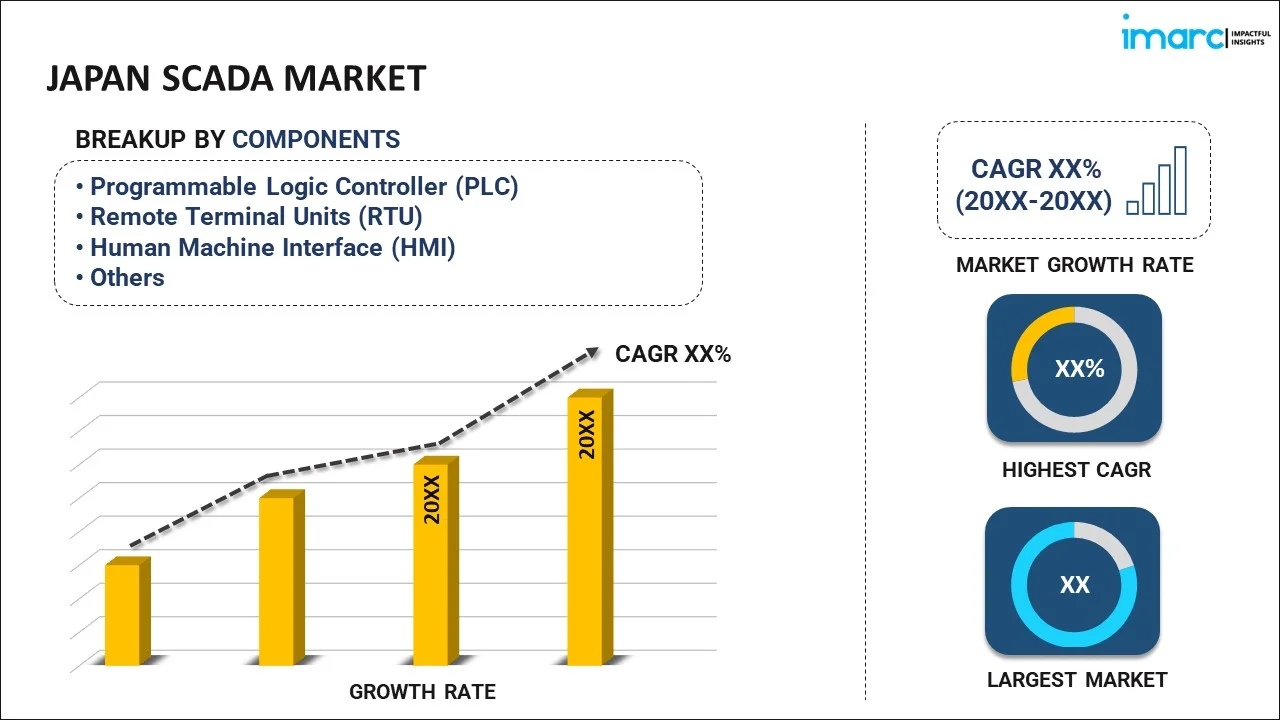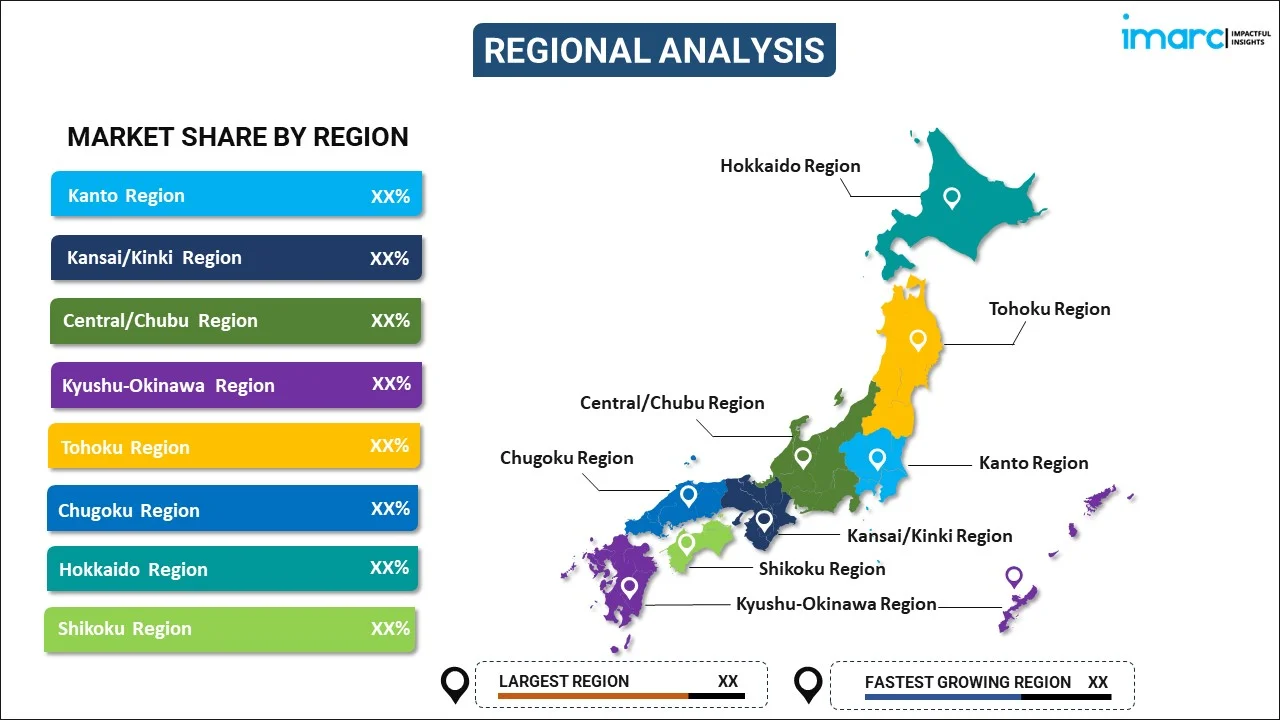
Japan SCADA Market Report by Component (Programmable Logic Controller (PLC), Remote Terminal Units (RTU), Human Machine Interface (HMI), Communication Systems, and Others), Architecture (Hardware, Software, Services), End User (Oil and Gas, Power, Water and Wastewater, Manufacturing, Chemicals and Petrochemicals, Pharmaceutical, and Others), and Region 2025-2033
Market Overview:
Japan SCADA market size reached USD 1.3 Billion in 2024. Looking forward, IMARC Group expects the market to reach USD 2.9 Billion by 2033, exhibiting a growth rate (CAGR) of 9.23% during 2025-2033. The growing trend toward automation in industries such as manufacturing, energy, oil and gas, water and wastewater, and transportation that require effective systems to enable real-time monitoring and control of complex processes is driving the market.
|
Report Attribute
|
Key Statistics
|
|---|---|
|
Base Year
|
2024 |
|
Forecast Years
|
2025-2033 |
|
Historical Years
|
2019-2024
|
| Market Size in 2024 | USD 1.3 Billion |
| Market Forecast in 2033 | USD 2.9 Billion |
| Market Growth Rate (2025-2033) | 9.23% |
SCADA, or supervisory control and data acquisition, is a system used in various industries to monitor and control processes and equipment remotely. It consists of software and hardware components that collect data from sensors and devices in real time and present it to human operators in a graphical interface. SCADA systems enable operators to monitor the status of industrial processes, detect anomalies, and make informed decisions. SCADA systems are crucial in industries such as manufacturing, energy, water treatment, and transportation. They allow for efficient process management, remote control, and data analysis. Operators can respond to alarms and take corrective actions, enhancing safety and productivity. Additionally, SCADA systems often integrate with other control systems, like PLCs (programmable logic controllers), to automate tasks and optimize operations. As technology evolves, SCADA systems continue to play a vital role in managing complex industrial processes, improving efficiency, and ensuring the reliability of critical infrastructure.
Japan SCADA Market Trends:
The SCADA market in Japan is experiencing robust growth, driven by several key factors. Firstly, the increasing complexity of industrial processes and the need for real-time monitoring and control have fueled the demand for SCADA systems. Moreover, the ongoing digital transformation across various industries has created a pressing need for automation and connectivity, further propelling the SCADA market forward. Additionally, the growing focus on energy efficiency and sustainability has prompted industries to adopt SCADA systems to optimize their operations and reduce energy consumption. Furthermore, the proliferation of IoT (Internet of Things) devices and the integration of SCADA with IoT technology have opened up new avenues for data collection and analysis, enhancing the overall efficiency and productivity of industrial processes. Furthermore, stringent regulatory requirements in sectors such as water and wastewater treatment, pharmaceuticals, and food and beverage are compelling organizations to invest in SCADA solutions to ensure compliance and operational transparency. Lastly, the increasing awareness of cybersecurity threats, which has led to greater investment in secure SCADA systems to protect critical infrastructure from potential cyberattacks, is expected to drive the market in Japan during the forecast period.
Japan SCADA Market Segmentation:
IMARC Group provides an analysis of the key trends in each segment of the market, along with forecasts at the country level for 2025-2033. Our report has categorized the market based on component, architecture, and end user.
Component Insights:

- Programmable Logic Controller (PLC)
- Remote Terminal Units (RTU)
- Human Machine Interface (HMI)
- Communication Systems
- Others
The report has provided a detailed breakup and analysis of the market based on the component. This includes programmable logic controller (PLC), remote terminal units (RTU), human machine interface (HMI), communication systems, and others.
Architecture Insights:
- Hardware
- Software
- Services
A detailed breakup and analysis of the market based on the architecture have also been provided in the report. This includes hardware, software, and services.
End User Insights:
- Oil and Gas
- Power
- Water and Wastewater
- Manufacturing
- Chemicals and Petrochemicals
- Pharmaceutical
- Others
The report has provided a detailed breakup and analysis of the market based on the end user. This includes oil and gas, power, water and wastewater, manufacturing, chemicals and petrochemicals, pharmaceutical, and others.
Regional Insights:

- Kanto Region
- Kansai/Kinki Region
- Central/ Chubu Region
- Kyushu-Okinawa Region
- Tohoku Region
- Chugoku Region
- Hokkaido Region
- Shikoku Region
The report has also provided a comprehensive analysis of all the major regional markets, which include Kanto Region, Kansai/Kinki Region, Central/ Chubu Region, Kyushu-Okinawa Region, Tohoku Region, Chugoku Region, Hokkaido Region, and Shikoku Region.
Competitive Landscape:
The market research report has also provided a comprehensive analysis of the competitive landscape in the market. Competitive analysis such as market structure, key player positioning, top winning strategies, competitive dashboard, and company evaluation quadrant has been covered in the report. Also, detailed profiles of all major companies have been provided.
Japan SCADA Market Report Coverage:
| Report Features | Details |
|---|---|
| Base Year of the Analysis | 2024 |
| Historical Period | 2019-2024 |
| Forecast Period | 2025-2033 |
| Units | Billion USD |
| Scope of the Report | Exploration of Historical Trends and Market Outlook, Industry Catalysts and Challenges, Segment-Wise Historical and Future Market Assessment:
|
| Components Covered | Programmable Logic Controller (PLC), Remote Terminal Units (RTU), Human Machine Interface (HMI), Communication Systems, Others |
| Architectures Covered | Hardware, Software, Services |
| End Users Covered | Oil and Gas, Power, Water and Wastewater, Manufacturing, Chemicals and Petrochemicals, Pharmaceutical, Others |
| Regions Covered | Kanto Region, Kansai/Kinki Region, Central/ Chubu Region, Kyushu-Okinawa Region, Tohoku Region, Chugoku Region, Hokkaido Region, Shikoku Region |
| Customization Scope | 10% Free Customization |
| Post-Sale Analyst Support | 10-12 Weeks |
| Delivery Format | PDF and Excel through Email (We can also provide the editable version of the report in PPT/Word format on special request) |
Key Questions Answered in This Report:
- How has the Japan SCADA market performed so far and how will it perform in the coming years?
- What has been the impact of COVID-19 on the Japan SCADA market?
- What is the breakup of the Japan SCADA market on the basis of component?
- What is the breakup of the Japan SCADA market on the basis of architecture?
- What is the breakup of the Japan SCADA market on the basis of end user?
- What are the various stages in the value chain of the Japan SCADA market?
- What are the key driving factors and challenges in the Japan SCADA?
- What is the structure of the Japan SCADA market and who are the key players?
- What is the degree of competition in the Japan SCADA market?
Key Benefits for Stakeholders:
- IMARC’s industry report offers a comprehensive quantitative analysis of various market segments, historical and current market trends, market forecasts, and dynamics of the Japan SCADA market from 2019-2033.
- The research report provides the latest information on the market drivers, challenges, and opportunities in the Japan SCADA market.
- Porter's five forces analysis assist stakeholders in assessing the impact of new entrants, competitive rivalry, supplier power, buyer power, and the threat of substitution. It helps stakeholders to analyze the level of competition within the Japan SCADA industry and its attractiveness.
- Competitive landscape allows stakeholders to understand their competitive environment and provides an insight into the current positions of key players in the market.
Need more help?
- Speak to our experienced analysts for insights on the current market scenarios.
- Include additional segments and countries to customize the report as per your requirement.
- Gain an unparalleled competitive advantage in your domain by understanding how to utilize the report and positively impacting your operations and revenue.
- For further assistance, please connect with our analysts.
 Inquire Before Buying
Inquire Before Buying
 Speak to an Analyst
Speak to an Analyst
 Request Brochure
Request Brochure
 Request Customization
Request Customization




.webp)




.webp)












